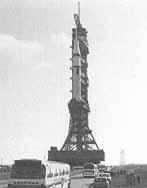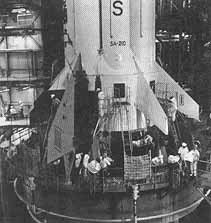
Reviewing Apollo Readiness
Within NASA, a series of additional reviews were conducted before 15 July. The Headquarters FRR was held at the Kennedy Space Center on 12 June, when representatives from the Johnson, Marshall, and Kennedy Space Centers gathered at the Cape to report on their respective pre-flight preparations. Glynn Lunney led off by summarizing the Moscow FRR and showing filmed highlights of the NASA team's visit to Baykonur Cosmodrome. The Technical Director said that he had been given full details on the April aborted Soyuz launch and explained the steps the Soviets had taken to prevent recurrence of the failure. M. P. Frank described the ASTP mission profile and enumerated the activities scheduled for the nine-day flight, and Arnold Aldrich listed the technical reviews to which the spacecraft had been subjected. Lunney's assistant went on to indicate that there were no spacecraft hardware "issues" - problems to be resolved prior to launch - with CSM 111, SLA-18, DM-2, or DS-5 that might interfere with an on-time lift-off. Gary A. Coultas of the Apollo Project Engineering Office presented a similar evaluation of government furnished equipment (the color television subsystem, photo optical equipment, space suits, and rescue equipment). Safety assessments for the spacecraft and experiment materials were delivered by Bobby J. Miller of the JSC Safety Office. After further remarks from Houston personnel on flight rules, mission control center readiness, flight controller, and crew preparedness, Ellery B. May, Saturn Program Manager at Marshall, reported on the Saturn IB launch vehicle.61
SA-210 had been built in 1967 and stored since then. By the date of the launch, several of its components would be nine years old. Since some of the materials used in fabricating the booster were subject to possible deterioration from aging, periodic inspections had been made to monitor the condition of its various components. May noted that during the course of one such routine inspection, cracks had been discovered in two of the mounting points for the large tail fins of the first stage. After an intensive study of the fins and the cracks (caused by stress corrosion), Marshall and Headquarters engineers decided to replace all eight of the first stage fins. Subsequent analysis and monitoring of the hardware indicated that this action had corrected the problem, and it appeared as a resolved anomaly in the FRR.* At the conclusion of his presentation, May stated that all...
|
|
Inside the high bay of the Vehicle Assembly Building at the Kennedy Space Center, work progresses on the replacement of the first-stage fins of ASTP's Saturn IB launch vehicle, March 1975. On 24 March the Saturn-Apollo 210 launch vehicle and spacecraft were moved out to the launch pad. A special lightning mast is atop the service tower. |
 |
....Marshall offices and contractors had been polled; they agreed that SA-210 was ready to fly.
KSC personnel provided data on the launch center's preparations for the flight. One of their major concerns was the possibility of thunderstorms and lightning strikes before and at the time of the launch. July was the worst time of the year for both at Cape Canaveral. William H. Rock, Manager for Sciences, Applications, and ASTP, spoke first for the launch team. In addition to covering all the ASTP-related modifications to the launch pad and control center, he gave some historical background on the ASTP lightning protection system installed on the mobile launcher. A lightning strike had long been a worry, one that had been reinforced by the twin bolts that had struck Apollo 12. To combat the effects of such a strike, the KSC team had installed a larger lightning rod atop the launch tower. This 25.6-meter fiberglass mast was designed so that the ground wires would not come any closer than 15 meters to the mobile launcher structure, thus eliminating the arcing of electrical current from the wires to the structure of the spacecraft. Rock noted that since 9 May four lightning strikes had been recorded; none had posed a threat to the hardware.** 62
[312] Although the lightning hazard appeared to have been minimized by the new arrestor, the possibility of rain storms and high winds still concerned the mission planners. Jesse R. Gulick, KSC staff meteorologist, reported on the weather prospects. Starting with a recapitulation of last year's storm patterns, he said that, according to current mission rules, "we could not have launched on one-third of the days, that several such days could occur in a row . . . [but] there was no time last year when we could not have launched within a period of four days." The thunderstorm probability for 15 July 1975 at the proposed lift-off hour was 23 percent. Probability of a tropical storm or hurricane winds affecting the KSC area was less than 3 percent. The mixed forecast, some good news and some bad, led to the crossing of fingers. While everyone hoped that they would not be needed, the mission planners were relieved that they had spent so much time working out alternative launch dates - just in case.63
Captain Lee took the floor after statements from KSC, Goddard (Spacecraft Tracking and Data Network), and Department of Defense personnel. He canvassed the Center Directors for comments, and they all remarked favorably on the preparations, expressing their confidence that the mission would be a success. George Low and John Yardley echoed these sentiments. Low said that he was especially impressed by all the effort and detail that had gone into building and checking out the ASTP hardware. Attention to detail had been one of the hallmarks of the Apollo and Skylab Programs, but he sensed a special feeling of pride behind the hard work and devotion of the ASTP team. Low believed that their energies would help assure a favorable outcome for the first international space flight. He asked them to continue their hard work until the mission was completed and the crews safely aboard the recovery ship. At the close of the FRR, Lee told the launch crews to continue with their preparations.64
* A chronology of SA-210 related events, including the stress corrosion problem, is presented in appendix F.
** The lengthy efforts related to lightning protection are documented in note 62.
61. NASA, OMSF, Apollo/Soyuz Test Program Office, "ASTP Flight Readiness Review," TM052-001-1 A, June 1975.
62. Lightning had been a problem since Mercury and Gemini, with the first major incident occurring on 17 Aug. 1964 when a lightning strike at launch complex 19 interrupted testing of Gemini Launch Vehicle 2. This and other problems caused postponement of the GLV-2 flight until 19 Jan. 1965. Subsequently, GT-5 was postponed when a similar near miss affected the onboard computers. This resulted in a two day delay. See James M. Grimwood, Barton C. Hacker, with Peter J. Vorzimmer, Project Gemini Technology and Operations; A Chronology, NASA SP-4002 (Washington, 1969), pp. 154 and 209. During the Apollo 12 launch, the spacecraft was affected by lightning-associated electrical disturbances at 36.5 and 52 seconds after liftoff. See NASA, "Analysis of Apollo 12 Lightning Incidents," MSC-01540, Feb. 1970. Following the Apollo 12 flight, greater attention was given to the lightning problem. For ASTP, see William R. Durett to Donald D. Arabian, memo, "KSC Lightning Research," 8 Aug.1973; Lee to William H. Rock, memo, "Impact of Lightning Strikes on the ASTP Mission," 30 Aug. 1973; Lee to Rock, memo, "Impact of Lightning Strikes on the ASTP Mission," 11 Dec. 1973; Rock to Lee, memo, "Impact of Lightning Strikes on the ASTP Mission," 20 Dec. 1973; Richard G. Smith to Rock, memo, "Impact of Lightning Strikes on the ASTP Mission," 16 Feb. 1974; Rock to distribution, memo, "ASTP Lightning Review," 27 Mar. 1974; Rock to Lee, memo, "Impact of Lightning Strike on the ASTP Mission," 1 Apr. 1974; TWX, Lee to Lunney, Ellery B. May, Rock, and Walter J. Kapryan, "Plan for Lightning Investigation at KSC, Summer, 1974," 24 Apr. 1974; Lee to Lunney, May, and Rock, memo, "ASTP Lightning Meeting," 20 May 1974; TWX, Lee to Lunney, Rock, Isom A. Rigell, and May, "Spacecraft Lightning Tests," 24 June 1974; May to Lee, memo, "AS-210 Simulated In-Flight Lightning Test," 27 June 1974; Rock to Lee, memo, "ASTP In-Flight Lightning Tests," 2 July 1974; Lee to Lunney, May, and Rock, memo, "ASTP Simulated In-Flight Lightning Tests," 25 July 1974; Lunney to Kapryan, memo, "Simulated Lightning Test on CSM 119," 9 Aug. 1974; TWX, Rock to Lee, "Simulated Lightning Tests at KSC," 15 Aug. 1974; Rock to distribution, memo, "Crew Safety Panel Approval, Concept of Lightning Protection System for ASTP," 12 Aug. 1974; Lee to Lunney, May, and Rock, memo, "Launch Mission Rules Changes for Lightning," 19 Aug. 1974; TWX, Lee to Lunney, May, and Rock, memo, "ASTP Simulated In-Flight Lightning Tests," 6 Sept. 1974; TWX, Lee to Rock, Lunney, and May, "Lightning Review," 3 Oct. 1974; Rock to distribution, memo, "ASTP Launch Mission Rule," 4 Nov. 1974; John F. Yardley to Low, memo, "ASTP Severe Weather Launch Rules," 20 June 1975; Robert L. Blount, Richard D. Gadbois, Dwight L. Suiter, and John A. Zill, NASA, JSC, "ASTP Simulated Lightning Test Report," JSC-09221, Nov. 1975; NASA News Release, KSC-30-75, "Saturn/Apollo Launch Tower Sports New Look, " 2 Mar. 1975; and NASA, OMSF, Apollo/Soyuz Test Program Office, "ASTP Flight Readiness Review," TM052-001-1 A, June 1975.
63. Charles J. Newman, Weather Bureau, Office of Meteorological Operations, Space Operations Support Division, Frequency and Duration of Thunderstorms at Cape Kennedy, Part 1, WBTM SOS-2 (Silver Spring, Md., June 1968); and NASA, OMSF, Apollo/Soyuz Test Program Office, "ASTP Flight Readiness Review," TM052-001-1A, June 1975.
64. NASA, OMSF,
Apollo/Soyuz Test Program Office, "ASTP Flight Readiness Review,"
TM052-001-1 A, June 1975; NASA News Release, MSFC, 75-119, "Apollo
Soyuz Flight Readiness Review Is Held," 12 June 1975; and NASA News
Release, KSC-104075, "ASTP Given Clearance for Final Preparations,"
12 June 1975. But Low still had some questions; see Low to Lee, memo,
"ASTP Questions," 16 June 1975.
Next
